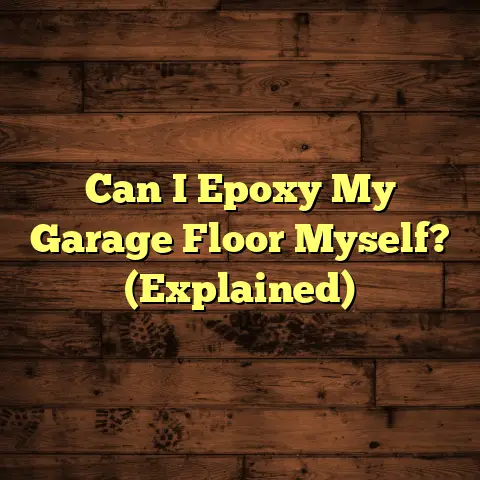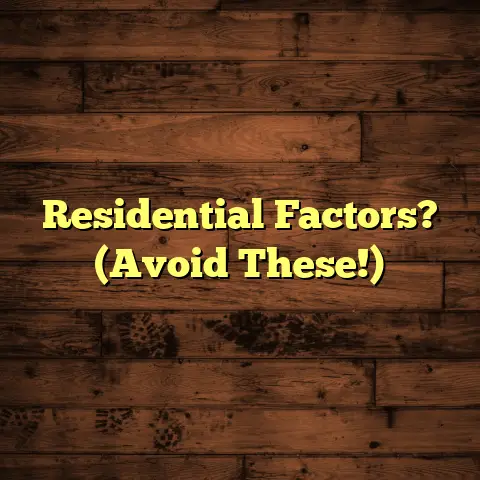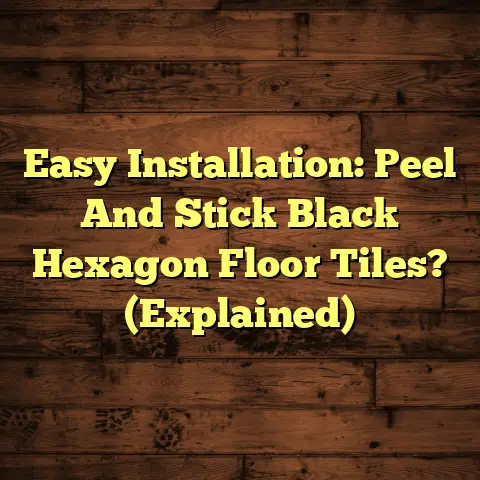Cleaning LVP Flooring: Best Way? (8 Cleaner Types!)
Let’s talk LVP flooring. There’s a big myth floating around that you can’t use water on it. I’m here to tell you that’s simply not true.
While excessive water can be a problem for some types of flooring, Luxury Vinyl Plank (LVP) is designed to handle moisture. That’s why it’s so popular in kitchens, bathrooms, and even basements.
I’ve seen countless homes transformed with LVP. Its resilience is a major selling point. But like any flooring, it needs proper cleaning to look its best and last for years.
So, let’s dive into the world of LVP cleaning and debunk some myths along the way!
Section 1: Understanding LVP Flooring
What exactly is LVP?
LVP is a multi-layered synthetic flooring product designed to mimic the look of natural materials like hardwood or stone. It’s typically composed of:
- A wear layer (the top layer that protects against scratches and stains)
- A decorative layer (the printed image that gives it its wood or stone look)
- A core layer (provides stability and water resistance)
- Sometimes, an attached underlayment for added comfort and sound insulation.
Why is LVP so popular?
It’s a fantastic option for modern homes and even commercial spaces for a few key reasons:
- Durability: LVP is tough and can withstand heavy foot traffic.
- Water Resistance: As I mentioned, it’s much more water-resistant than hardwood.
- Aesthetic Appeal: The advancements in printing technology mean LVP can realistically mimic the look of expensive materials at a fraction of the cost.
- Cost-Effective: Compared to hardwood or tile, LVP is often more budget-friendly.
Why is regular cleaning important?
Think of it this way: even the toughest flooring needs some TLC. Regular cleaning and maintenance will:
- Prolong the life of your LVP.
- Keep it looking beautiful and vibrant.
- Prevent the buildup of dirt and grime that can dull the finish.
- Maintain a healthy indoor environment by removing allergens and bacteria.
Section 2: Importance of Choosing the Right Cleaner
Okay, so you know LVP needs cleaning. But grabbing any old cleaner off the shelf is a big no-no.
Why is the right cleaner so important?
Using the wrong cleaning products can cause serious damage to your LVP flooring:
- Dulling the Finish: Harsh chemicals can strip away the protective wear layer, making your floors look dull and lifeless.
- Discoloration: Some cleaners can react with the LVP material, causing discoloration or staining.
- Damage to the Seams: Harsh chemicals can weaken the seams between planks, leading to water damage and eventual failure.
pH-Neutral vs. Harsh Chemicals
This is a crucial distinction.
- pH-Neutral Cleaners (pH of 7): These are gentle and won’t damage the LVP finish. They effectively remove dirt and grime without harsh chemicals.
- Harsh Chemicals (High or Low pH): Cleaners with very high or low pH levels (like bleach or ammonia) can be corrosive and damage the LVP.
Factors to Consider When Selecting a Cleaner
- Finish Type: Some LVP has a matte finish, while others are glossier. Choose a cleaner formulated for your specific finish.
- Manufacturer Recommendations: Always check the manufacturer’s website or warranty information for specific cleaning recommendations.
- Ingredients: Avoid cleaners with abrasive ingredients, harsh chemicals, or solvents.
Section 3: Overview of Cleaning Methods
Before we dive into specific cleaners, let’s quickly review the different cleaning methods you can use on LVP:
-
Dry Cleaning: This involves using a broom, dust mop, or vacuum to remove loose dirt and debris. It’s ideal for daily or weekly maintenance.
- Pros: Quick, easy, and prevents water damage.
- Cons: Doesn’t remove stuck-on dirt or stains.
-
Wet Cleaning: This involves using a mop and cleaning solution to remove dirt, grime, and stains. It’s best for deeper cleaning.
- Pros: Effectively removes dirt and stains, sanitizes the floor.
- Cons: Can potentially cause water damage if not done properly.
-
Steam Cleaning: Uses hot steam to sanitize and clean the floor.
- Pros: Chemical-free, sanitizes effectively.
- Cons: Can damage some LVP if the heat is too high or the steam is left in one spot for too long.
The best method depends on the level of cleaning needed and the type of LVP you have. Always test a small, inconspicuous area first!
Section 4: The Eight Types of Cleaners for LVP Flooring
Alright, let’s get to the meat of the matter: the best cleaners for your LVP floors!
-
pH-Neutral Floor Cleaners
As I mentioned earlier, pH-neutral cleaners are your best friend when it comes to LVP. They clean effectively without damaging the finish.
- What does pH-neutral mean? It means the cleaner has a pH of around 7, which is neither acidic nor alkaline.
- Why is it essential for LVP? Because it won’t strip away the protective wear layer or cause discoloration.
Recommended Brands and Product Types:
- Bona Stone, Tile & Laminate Floor Cleaner: A popular choice specifically formulated for hard surface floors like LVP.
- Armstrong Flooring Once ‘n Done Resilient & Ceramic Floor Cleaner: Another great option designed for vinyl and other resilient flooring types.
- Method Squirt + Mop Hard Floor Cleaner: A plant-based, pH-neutral option that’s safe for LVP and the environment.
Effective Usage Tips:
- Always dilute the cleaner according to the manufacturer’s instructions.
- Use a microfiber mop for best results.
- Avoid using excessive amounts of water.
- Rinse the floor with clean water if necessary.
-
Homemade Cleaner Solutions
Want to save some money and use what you already have at home? You can create effective LVP cleaners with common household ingredients.
DIY Cleaner Recipes:
- Vinegar and Water: Mix 1/2 cup of white vinegar with 1 gallon of warm water. This is a great all-purpose cleaner.
- Dish Soap and Water: Add a few drops of mild dish soap to a gallon of warm water. Be sure to use a very small amount of soap to avoid residue.
- Baking Soda Paste: For stubborn stains, make a paste of baking soda and water. Apply to the stain, let it sit for a few minutes, and then gently scrub.
Benefits and Potential Pitfalls:
- Benefits: Cost-effective, readily available ingredients, environmentally friendly.
- Pitfalls: Vinegar can be too acidic for some LVP finishes, dish soap can leave a residue if not rinsed properly, and baking soda can be abrasive if used too vigorously.
Important Note: Always test any homemade solution in an inconspicuous area before applying it to the entire floor.
-
Steam Cleaners
Steam cleaning is a chemical-free way to sanitize your LVP floors. The hot steam effectively kills bacteria and removes dirt and grime.
How to Use Steam Cleaners Safely on LVP:
- Use a low steam setting: High heat can damage some LVP.
- Keep the steam moving: Don’t leave the steam cleaner in one spot for too long.
- Use a microfiber pad: This will help absorb excess moisture.
- Check the manufacturer’s instructions: Some LVP manufacturers don’t recommend steam cleaning.
Advantages of Using Steam:
- Chemical-free cleaning.
- Effective sanitization.
- Removes dirt and grime without harsh chemicals.
Disadvantages of Using Steam:
- Can damage some LVP if not used properly.
- May not be effective on stubborn stains.
-
Commercial Vinyl Floor Cleaners
These are specialized cleaners specifically designed for vinyl flooring, including LVP. They often contain ingredients that protect and enhance the finish of your floors.
Recommended Commercial Cleaners:
- Rejuvenate Luxury Vinyl Floor Cleaner: A popular choice that cleans, shines, and protects LVP.
- Weiman Hardwood Floor Cleaner and Polish: While marketed for hardwood, this cleaner is also safe and effective on LVP. It leaves a nice shine.
- Zep Commercial Neutral Floor Cleaner: A concentrated cleaner that’s pH-neutral and safe for all types of hard floors, including LVP.
Effectiveness and Unique Application Methods:
- Commercial vinyl floor cleaners are typically very effective at removing dirt, grime, and stains.
- Some require dilution, while others are ready-to-use.
- Always follow the manufacturer’s instructions for application.
-
Microfiber Mops and Pads
Microfiber is a game-changer when it comes to cleaning LVP. The tiny fibers are incredibly effective at trapping dust, dirt, and grime.
Effectiveness of Microfiber:
- Microfiber cloths and mops are much more effective than traditional cotton mops.
- They lift and trap dirt instead of just pushing it around.
- They’re also very absorbent, which helps prevent water damage.
Recommended Products and Techniques:
- O-Cedar EasyWring Microfiber Spin Mop: A popular and effective spin mop with a microfiber head.
- Swiffer Sweeper with Microfiber Cloths: A convenient option for dry dusting and light cleaning.
- Technique: Use a slightly damp microfiber mop or cloth to clean your LVP floors. Avoid using excessive amounts of water.
-
Spot Cleaners for Stains
Accidents happen! When you have a stain on your LVP, it’s important to act quickly and use the right spot cleaner.
Common Stains and Best Products:
- Food and Drink Stains: A mixture of dish soap and water or a commercial vinyl floor cleaner.
- Grease Stains: Baking soda paste or a degreasing cleaner.
- Ink Stains: Rubbing alcohol or a commercial ink remover.
- Pet Stains: An enzymatic cleaner specifically designed for pet stains.
Step-by-Step Stain Removal Instructions:
- Blot the stain with a clean cloth to remove as much of the liquid as possible.
- Apply the appropriate spot cleaner to the stain.
- Let it sit for a few minutes (follow the manufacturer’s instructions).
- Gently scrub the stain with a soft cloth or brush.
- Rinse the area with clean water and dry with a clean cloth.
-
Floor Polish and Restorers
Over time, LVP can lose its shine. Floor polish and restorers can help bring back the luster and protect the surface.
Use of Floor Polish:
- Floor polish adds a protective layer to the LVP, helping to prevent scratches and scuffs.
- It also enhances the shine of the floor.
Recommended Products:
- Rejuvenate All Floors Restorer and Polish: A popular choice that restores shine and protects LVP.
- Quick Shine Multi-Surface Floor Finish and Polish: Another great option for adding shine and protection.
When to Use Them:
- Use floor polish every few months or as needed to maintain the shine of your LVP.
- Always follow the manufacturer’s instructions for application.
-
Eco-Friendly Cleaners
If you’re concerned about the environment, there are plenty of eco-friendly cleaners that are safe and effective for LVP.
Importance of Sustainability:
- Eco-friendly cleaners are made with plant-based ingredients and are biodegradable.
- They don’t contain harsh chemicals that can harm the environment or your health.
Examples of Eco-Friendly Cleaners:
- Better Life Floor Cleaner: A plant-derived cleaner that’s safe for LVP and the environment.
- Puracy Multi-Surface Cleaner: A natural, plant-based cleaner that’s effective on a variety of surfaces, including LVP.
- Common Good Floor Cleaner: A sustainable, refillable cleaner that’s safe for LVP.
Section 5: Step-by-Step Cleaning Process
Okay, let’s put it all together. Here’s a step-by-step guide on how to clean your LVP flooring using a pH-neutral cleaner:
-
Gather Your Supplies: You’ll need a pH-neutral floor cleaner, a microfiber mop, a bucket, and a vacuum or broom.
-
Dry Clean the Floor: Use a vacuum or broom to remove any loose dirt, dust, and debris from the floor.
-
Prepare the Cleaning Solution: Dilute the pH-neutral cleaner according to the manufacturer’s instructions.
-
Mop the Floor: Dip the microfiber mop into the cleaning solution and wring out the excess water. Mop the floor in overlapping strokes, working in small sections.
-
Rinse the Floor (Optional): If necessary, rinse the floor with clean water to remove any remaining cleaning solution.
-
Dry the Floor: Use a clean, dry microfiber cloth to dry the floor.
Tips for Routine Maintenance:
- Sweep or vacuum your LVP floors regularly to remove loose dirt and debris.
- Wipe up spills immediately to prevent staining.
- Use doormats at entrances to trap dirt and prevent it from being tracked onto the floor.
- Use furniture pads under furniture legs to prevent scratches.
Tips for Deep Cleaning:
- Deep clean your LVP floors every few months to remove built-up dirt and grime.
- Use a commercial vinyl floor cleaner or a homemade solution of vinegar and water.
- Consider using a steam cleaner for deep cleaning and sanitizing.
Section 6: Common Mistakes to Avoid
Let’s talk about some common pitfalls to avoid when cleaning LVP:
- Using Abrasive Cleaners: As I’ve stressed, avoid anything too harsh.
- Using Too Much Water: Excessive water can seep into the seams and damage the core layer of the LVP.
- Using a Dirty Mop: A dirty mop will just spread dirt around.
- Not Rinsing Properly: Leaving cleaning solution on the floor can create a sticky residue.
- Ignoring Manufacturer Recommendations: Always check the manufacturer’s website for specific cleaning instructions.
Solutions to These Mistakes:
- Always use pH-neutral cleaners specifically designed for LVP.
- Use a slightly damp mop and wring out excess water.
- Wash your mop head regularly.
- Rinse the floor with clean water if necessary.
- Follow the manufacturer’s recommendations for cleaning.
Conclusion: Final Thoughts on LVP Flooring Care
So, there you have it! Cleaning LVP flooring doesn’t have to be a daunting task. By choosing the right cleaner and following these simple tips, you can keep your LVP floors looking beautiful for years to come.
Remember, regular maintenance is key to prolonging the life of your flooring. Take pride in your flooring choices and enjoy the beauty and durability of your LVP!





